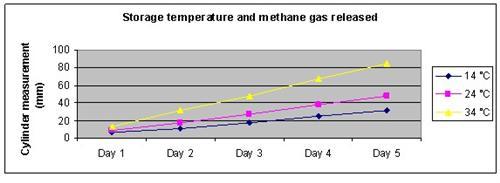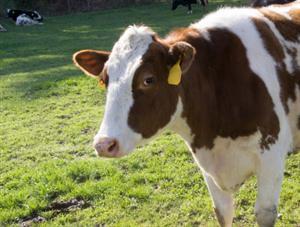| Complexity level: | 7 |
| Project cost ($): | 50 |
| Time required: | 3 hours for preparation, 5 days to conduct this science project |
| Material availability: | You will need to obtain samples of cow manure for this science project |
| Safety concerns: | None. |
Hypothesis
The container stored at 34 °C will produce the most methane gas.
Overview
Dairy waste treatment
Dairy waste can be treated in anaerobic lagoons, which provide treatment of the animal waste with minimal release of odor. These anaerobic lagoons are also able to decompose more organic material in per unit volume as compared to aerobic lagoons.
The advantages of an anaerobic lagoon are that animal manure can be handled by hydraulics using flushing systems, pumps and sewer pipes. The amount of odor released is much less, while the level of nitrogen in the manure is also lower. The lagoon also provides long-term storage for these wastes, with very little cost incurred. However, the disadvantage of using an anaerobic lagoon is the public perception that it is a tank of manure. Some odor may be released at certain times of the year during seasonal changes. The lack of nitrogen will also limit the use of the manure as a fertilizer.
The lagoon should ideally be located in lower grounds compared to the source of the waste, so that gravity can be used to flush the waste into the lagoon. Clay soil is the most economical and suitable for the construction of the lagoon.
Scientific Terms
Materials
The materials required for the experiment:
- 3 Erlenmeyer flasks
- 3 corks to stopper the flasks
- 1 nail
- 3 tubes
- Cow manure
- Tap water
- 3 measuring cylinders
- 3 basins
- 1 refrigerator
- 1 hot plate
- 1 ruler
Procedure
1. For this experiment, the independent variable is the temperature at which the manure in the flasks is kept – at 14 °C, 24 °C and 34 °C. The dependent variable is the amount of methane gas collected in the measuring cylinder. This is determined by observing and taking the measurement of the gas level from the cylinder every day. The constants (control variables) are the amount of cow manure and the size of the Erlenmeyer flask used.
2. Using the nail, make a hole in the middle of each of the 3 corks. The hole should be just big enough for the tube to be inserted into the cork.
3. Scoop an equal amount of cow manure into each Erlenmeyer flask. You can ascertain this by the weight of the flasks. Then, fill each flask with water. Insert a tube into each cork, then seal each Erlenmeyer flask tightly with the corks.
4. Fill each of the 3 basins with tap water. Fill each measuring cylinder with water and invert it inside the basin, as per Figure 1. Place the loose end of each tube inside a measuring cylinder.
5. Place one set-up inside a refrigerator, with the temperature set to 14 °C. Leave the second set at room temperature, or 24 °C, and place the third set on a hot plate, with the temperature maintained at 34 °C.
6. Observe the amount of methane gas released into each measuring cylinder every day for 5 days. Record the measurements in a table, as shown below.

Results
The results show that the manure in the Erlenmeyer flask that was stored at 34 °C produced the most methane gas.
| Storage temperature | Methane gas produced by anaerobic process in manure (mm) | ||||
| Day 1 | Day 2 | Day 3 | Day 4 | Day 5 | |
| 14 °C | 6 | 11 | 17 | 25 | 32 |
| 24 °C | 9 | 17 | 27 | 38 | 48 |
| 34 °C | 13 | 31 | 48 | 67 | 85 |
The graph below represents the results of the above table:

Conclusion
The hypothesis that the container stored at 34 °C will produce the most methane gas has been proven to be true.
Methane gas is obtained from the manure of animals when anaerobic decomposition of the manure takes place in the absence of oxygen. The methane gas can be used as a source of fuel for cooking stoves or to power a generator to produce electricity. The combination of carbon dioxide and methane is called biogas and is also a source of renewable energy.
Some power and gas companies in the United States, such as Pacific Gas and Electric and BioEnergy Solutions have commenced production of renewable energy using animal waste. Their biogas-to-pipeline injection project in Fresno County is an example of this advancement in energy production.
Also consider
Try to repeat the experiment using rotting vegetables or other organic material.
References
Treatment of dairy waste - http://extension.missouri.edu/publications/DisplayPub.aspx?P=WQ304
From waste to watts - http://www.kqed.org/quest/files/download/27/113a_fromwastetowatts.pdf
Biogas generator - http://www.re-energy.ca/pdf/biogas-generator.pdf

